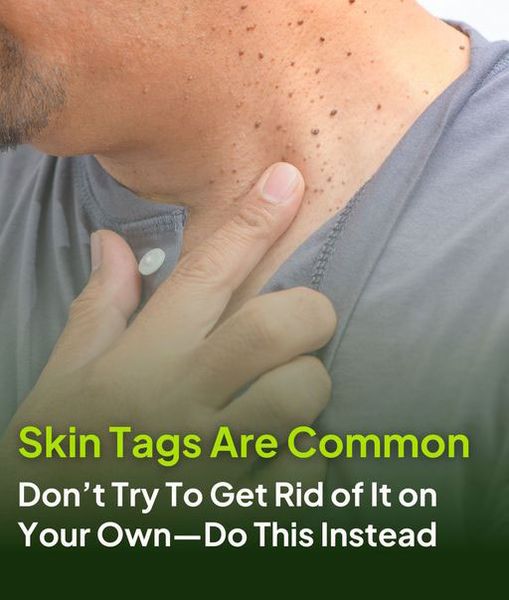Skin tags, medically known as acrochordons, are small, benign growths that commonly appear on your skin. Typically, they develop in areas where there’s friction: skin on skin or skin on clothing, like the neck, armpits, groin, under the breasts, and eyelids. They’re made of collagen fibers and blood vessels surrounded by skin, so these growths are harmless but can be annoying or unsightly. According to experts, they affect about half of the entire adult population at some point in their lives.1
Who Gets Skin Tags?

While they can grow on anyone, there are certain factors that increase the likelihood of development. They are more prevalent among:
Older adults: More commonly seen in people over the age of 50.2
People with a family history: Genes plays a major role in the likelihood of skin tag development.
Individuals with diabetes: Research has indicated a strong correlation between them and type 2 diabetes.
People with obesity: Excess weight can lead to skin folds, increasing friction and, therefore, the likelihood of getting them.
Pregnant women: Hormonal changes during pregnancy can contribute to them forming.
Signs and Symptoms

The small growths that stick out of the skin are called peduncles. They also vary in size; with some only a few millimeters long while others stick out to a few centimeters. While often painless, skin tags can become irritated or bleed if they are continuously rubbed or experience more friction from clothing, jewelry, or agitating activities like shaving. Typical shapes include:
Round or oval-shaped: Skin tags can resemble and be mistaken for a small mole.3
Soft and smooth: Their texture is generally soft, and is easily manipulated.
Color variations: They may match your skin tone but can also be slightly darker or lighter.
Causes of Skin Tags

Friction: Rubbing or friction against clothing or anything else is the primary cause of skin tags.4
Aging: As gravity pulls and loosens out skin with age, skin tags become more common.
Hormones: Fluctuations in hormones may trigger them.
Genetics: A family history can increase one’s likelihood of developing them.
Some studies also suggest a potential link to human papillomavirus (HPV), but the jury is still out and more research is needed to confirm.
Diagnosis

Skin tags are harmless, but are usually diagnosed through a simple visual examination by a healthcare provider. Being on your skin, they’re generally easy to spot. If you can’t see it, its probably isn’t here. The doctor will assess the size, shape, and color of the growth and its location on the body. In rare cases, if one seems abnormal, a biopsy might be required.
Treatments for Skin Tags

While skin tags pose no health risks and don’t require treatment, many people do opt to have them removed for cosmetic reasons. It is noted that these procedures should be performed by a dermatologist or a healthcare provider to minimize the risk of infection or complications. Professional removal methods include:
Cryosurgery: Cryosurgery involves using liquid nitrogen to freeze the culprit and have it fall off after a few days.
Electrodesiccation: As the name suggests, an electric current is used to destroy it.
Laser therapy: A specialist uses a focused laser for removal.
Surgical excision: The skin tag is removed via standard surgery with a scalpel or scissors.
Natural Remedies

For those who would rather opt for a home remedy, there are a few options that can help skin tags dry out and fall off. However, these methods should be used with caution:
Tea tree oil: With its antifungal and antiviral properties, tea tree oil can be applied to help dry things out over time.
Apple cider vinegar: Soak a cotton ball in apple cider vinegar, then apply it to help break down the tissue. In time, it should fall off on its own.
Vitamin E oil: Rubbing vitamin E oil on and around a skin tag can help moisturize it and reduce irritation, which could potentially help in the removal process.
Prevention

Preventing skin tags may not really be possible, but some steps can be taken reduce the risk of getting them:
Manage your blood sugar levels: For those with diabetes or any metabolic syndromes, keeping your blood sugar levels in check can help reduce the risks.
Use gentle skincare products: Using mild soaps and moisturizers (there are ones specifically marketed as such, don’t worry) can reduce irritation and friction on your skin.
Related Conditions

Other liked medical conditions include:
Birt-Hogg-Dubé syndrome: A rare genetic disorder that can cause multiple skin tags along with lesions. If you’re finding multiple popping up, consult your doctor.
Polycystic ovary syndrome (PCOS): This hormonal disorder has been seen to increase the likelihood of developing skin tags. But no lesions.
Living With Skin Tags

While skin tags are harmless, they can be bothersome if they become irritated or cause cosmetic concerns. Wearing loose-fitting clothing, avoiding jewelry that rubs against the skin, and maintaining good hygiene can help prevent skin irritation. Be sure to consult a healthcare provider for removal options if you want to explore that option. Although they are not harmful, various treatment options are available for those who wish to remove them.
